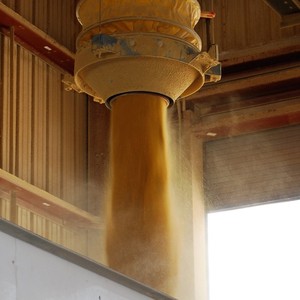DDGS movement shifts from containers to barge, rail

May 5, 2017
BY Sean Broderick, CHS
Most ethanol plants finished their spring maintenance schedules by early May and got back to running at full pace. DDGS demand from Asia remains weak, so the normally robust Chicago container loading market has lost a bit of its importance as a destination for all but nearby plants. Lately, a lot of DDGS has been loaded into barges on the Ohio, Illinois and Mississippi rivers, although rain events have tempered those movements lately.
In the domestic market, DDGS is (or should be) at full inclusion rates for all animal sector rations. Given its value of about 70 to 80 percent the value of delivered corn, and a big discount per unit of protein versus soymeal, it is hard to find an ingredient that is more economically efficient in an animal diet. As a result, we’re seeing more railcars and trucks moving product to eastern hog and southeastern poultry barns. Buyers have been looking to book the forward months around current spot prices, but, based on margin calculations, plants have been reluctant to sell.
On the export side, the bulk markets supplied by railcars and barges have displaced a healthy amount of tonnage previously destined for containers in Chicago and East Coast ports. Turkey continues to be an important export destination, passing Mexico in March as the largest monthly volume destination. Boats are loading out of the Gulf (via barges) and off the West Coast (out of railcars). Mexico has continued to be a good destination for loaded trains, although the NAFTA discussions and resulting impacts on exchange rates, are generating more questions than answers at times.
The planting season is off to an uneven start for market watchers, and events in Washington, D.C., will require continued attention as the season unfolds.
|
LOCATION |
June 2017 |
May 2017 |
June 2016 |
Advertisement
Advertisement
Minnesota
92
92
120
Chicago
104
103
140
Buffalo, N.Y.
125
Advertisement
Advertisement
120
140
Central Calif.
156
150
179
Central Fla.
148
148
155
Related Stories
The U.S. exported 31,160.5 metric tons of biodiesel and biodiesel blends of B30 and greater in May, according to data released by the USDA Foreign Agricultural Service on July 3. Biodiesel imports were 2,226.2 metric tons for the month.
CARB on June 27 announced amendments to the state’s LCFS regulations will take effect beginning on July 1. The amended regulations were approved by the agency in November 2024, but implementation was delayed due to regulatory clarity issues.
Legislation introduced in the California Senate on June 23 aims to cap the price of Low Carbon Fuel Standard credits as part of a larger effort to overhaul the state’s fuel regulations and mitigate rising gas prices.
The government of Brazil on June 25 announced it will increase the mandatory blend of ethanol in gasoline from 27% to 30% and the mandatory blend of biodiesel in diesel from 14% to 15%, effective Aug. 1.
The U.S. EIA reduced its 2025 and 2026 production forecasts for a category of biofuels that includes SAF in its latest Short-Term Energy Outlook, released June 10. The forecast for 2025 renewable diesel production was also revised down.
Upcoming Events









